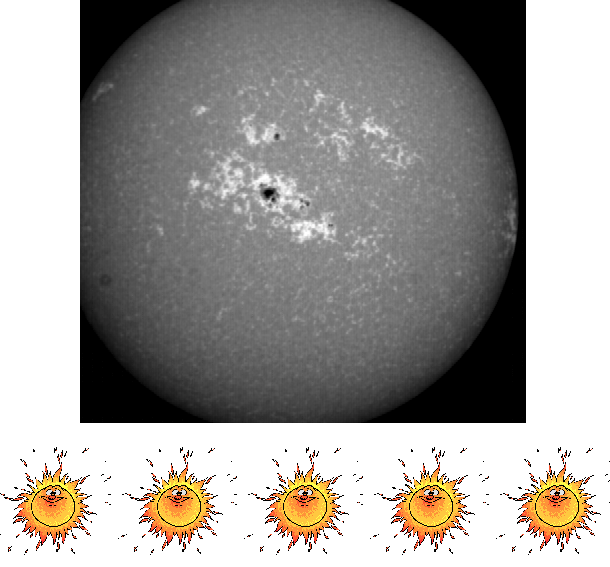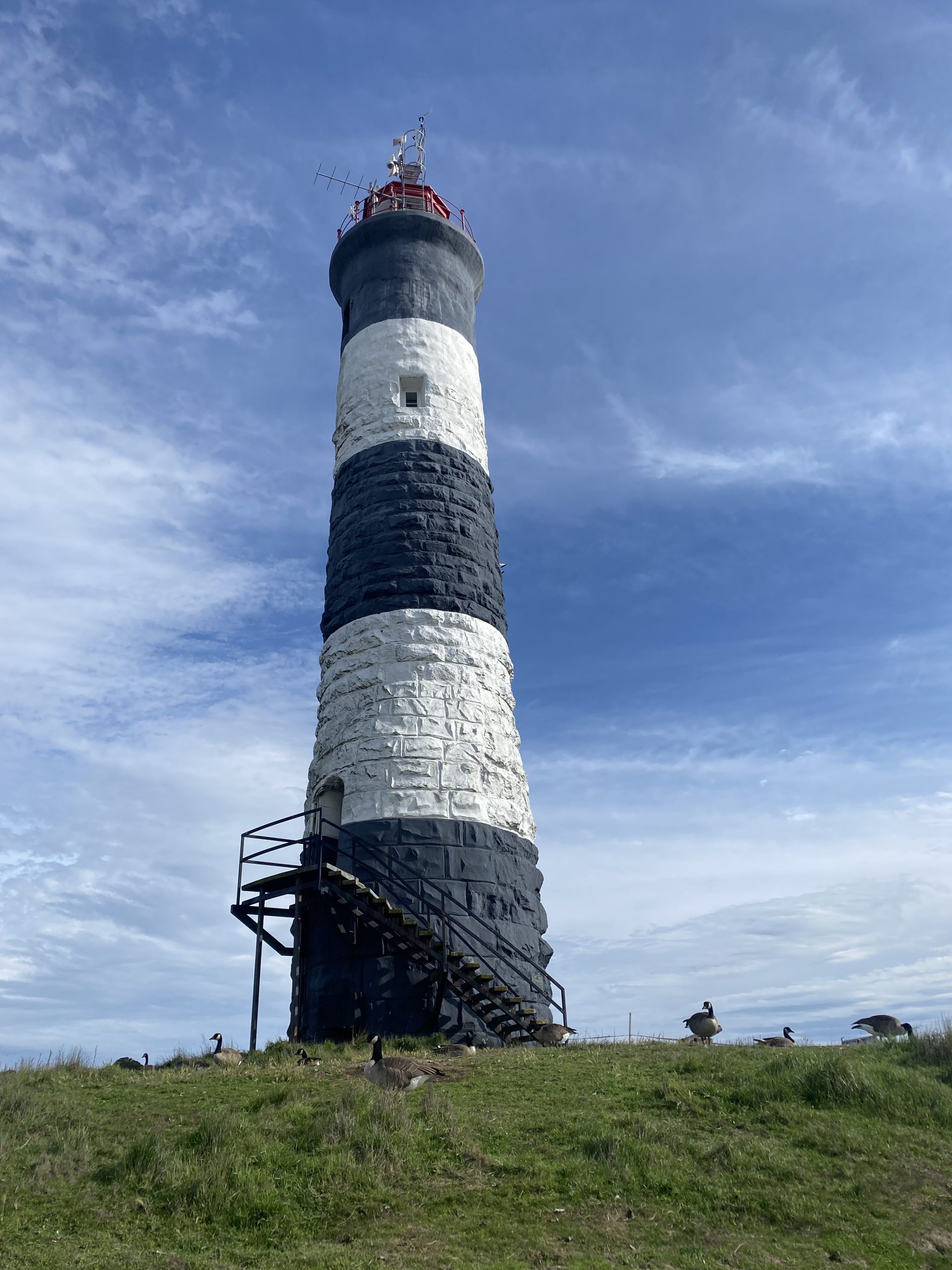Link to Effects of Solar energy on organisms
at Race Rocks:
The SOLAR ENERGY part of the
Integrated Energy Project at Race Rocks
Alternate Energy: Solar, A curriculum resource
For the following graphs of Solar Insolation,
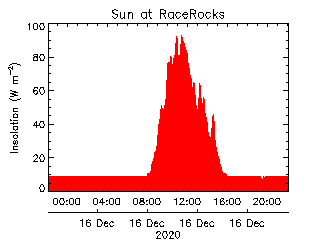 Click on this graph for today’s solar level at Race Rocks. the intensity of the incoming radiation is measured in Watts per square metre (Wm-2)
Click on this graph for today’s solar level at Race Rocks. the intensity of the incoming radiation is measured in Watts per square metre (Wm-2)
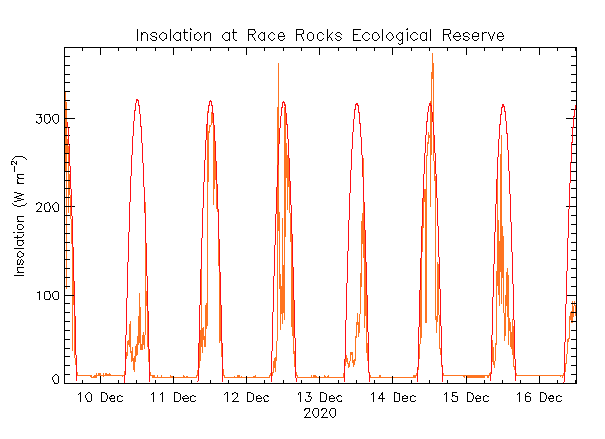 Click on this graph for the past week’s solar level at Race Rocks.
Click on this graph for the past week’s solar level at Race Rocks.
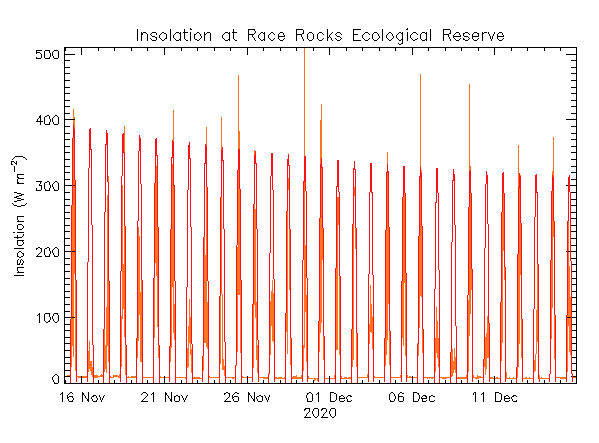 Click on this graph for the past month’s solar level at Race Rocks.
Click on this graph for the past month’s solar level at Race Rocks.
Our data from our Davis Weather Instrument is forwarded to the Vancouver Island School-Based Weather Station Network victoriaweather.ca which makes our graphs possible.
| Solar Energy history for the past week: The amount of accumulated solar radiation energy over a period of time measured in Langleys; 1 Langley= 11.622 Watt-hours per square meter =41.84 kilojoules per sqare metre =3.687 BTUs per square foot |
| AN EXPLANATION OF WHAT THE SOLAR MEASUREMENT REPRESENTS |
| As the Earth orbits the Sun, it receives approximately 1,400 W / m? of energy, as measured upon a surface kept normal (at a right angle) to the Sun (this number is referred to as the solar constant). Of the energy received, roughly 19% is absorbed by the atmosphere, while clouds on average reflect a further 35% of the total energy. The generally accepted standard is 1020 watts per square meter at sea level. |
| website on the Basics of Solar Energy
|
| Incident Solar Energy on the ground:• Average over the entire earth = 164 Watts per square meter over a 24 hour day So the entire planet receives 84 Terrawatts of Power our current worldwide consumption is about 12 Terrawatts so is this a solution? |
| Broadband Solar Irradiance – theoretically the solar radiation arriving at the earth from all frequencies or wavelengths, in practice limited to the spectral range of radiometers, typically from 300 nm to 3000 nm wavelength. Meteorologists refer to this band as short-wave radiation. |
| Electromagnetic Radiation – the energy produced by an oscillating electrical (and magnetic) field, transmitted by photons. See Electromagnetic Spectrum – the entire energy range of electromagnetic radiation specified by frequency, wavelength, or photon energy. The low end of the spectrum is infrared radiation (heat), and passes through the colors of visual light from red through violet, through ultraviolet radiation, x-rays, and gamma rays. Radio and television are transmitted on specific electromagnetic frequencies. |
| Shortwave Radiation – the principal portion of the solar spectrum that spans from approximately 300 nanometers (nm) to 4000 nm in the electromagnetic spectrum. Longwave radiation is infrared radiation (>4000 nm). |
| Watt – a unit of power defined as a Joule per second.. A Joule is – a metric energy unit (Newton-meter) equal to approximately 0.2389 calories. |
| Btu – British Thermal Unit, the amount of energy required to raise one pound of water one degree Farenheit at 60°F, equivalent to 1055 joules or 252.1 calories. |
| LuxThe lux (symbolized lx) is the unit of illuminance in the International System of Units (SI). It is defined in terms of lumens per meter squared (lm/m2). Reduced to SI base units, one lux is equal to 0.00146 kilogram per second cubed (1.46 x 10-3 kg / s3). One lux is the equivalent of 1.46 milliwatt (1.46 x 10-3 W) of radiant electromagnetic (EM) power at a frequency of 540 terahertz (540 THz or 5.40 x 1014 Hz), impinging at a right angle on a surface whose area is one square meter. A frequency of 540 THz corresponds to a wavelength of about 555 nanometers (nm), which is in the middle of the visible-light spectrum. The lux is a small unit. An alternative unit is the watt per meter squared (W / m2). To obtain lux when the illuminance in watts per meter squared is known, multiply by 683.To obtain watts per meter squared when the illuminance in lux is known, divide by 683 or multiply by 0.00146. Illuminance varies inversely with the square of the distance from the source on a free-space line of sight. If the distance is doubled, the illuminance is cut to 1/4; if the distance increases by a factor of 10, the illuminance becomes 1/100 (0.01 times) as great. |
| lumenThe lumen (symbolized lm) is the International Unit of luminous flux. It is defined in terms of candela steradians (cd multiplied by sr). One lumen is the amount of light emitted in a solid angle of 1 sr, from a source that radiates to an equal extent in all directions, and whose intensity is 1 cd. One lumen is the equivalent of 1.46 milliwatt (1.46 x 10-3 W) of radiant electromagnetic (EM) power at a frequency of 540 terahertz (540 THz or 5.40 x 1014 Hz). Reduced to SI base units, one lumen is equal to 0.00146 kilogram meter squared per second cubed (1.46 x 10-3 kg multiplied by m2 / s3). The lumen is a small unit. An electromagnetic field power level of 1.46 milliwatt is small; the radio-frequency (RF) output of a children’s toy two-way radio is several times that much. A frequency of 540 THz corresponds to a wavelength of about 556 nanometers (nm), which is in the middle of the visible-light spectrum. A steradian is the standard unit solid angle in three dimensions; a sphere encloses 4 pi (approximately 12.57) steradians. The Davis Weather Instrument provides a measure of solar radiation in Langleys: This is Solar Radiation Integrated over time. One Langley equals 11.622 Watt hours per square meter= 697.32 Watt minutes per square meter. |
 The solar cycle text and graphichttps://spaceplace.nasa.gov/solar-cycles/en/ files explain the Solar Cycle The solar cycle text and graphichttps://spaceplace.nasa.gov/solar-cycles/en/ files explain the Solar Cycleprogression. You will find here sunspot activity and an explanation of how it interferes with telecommunications. |
